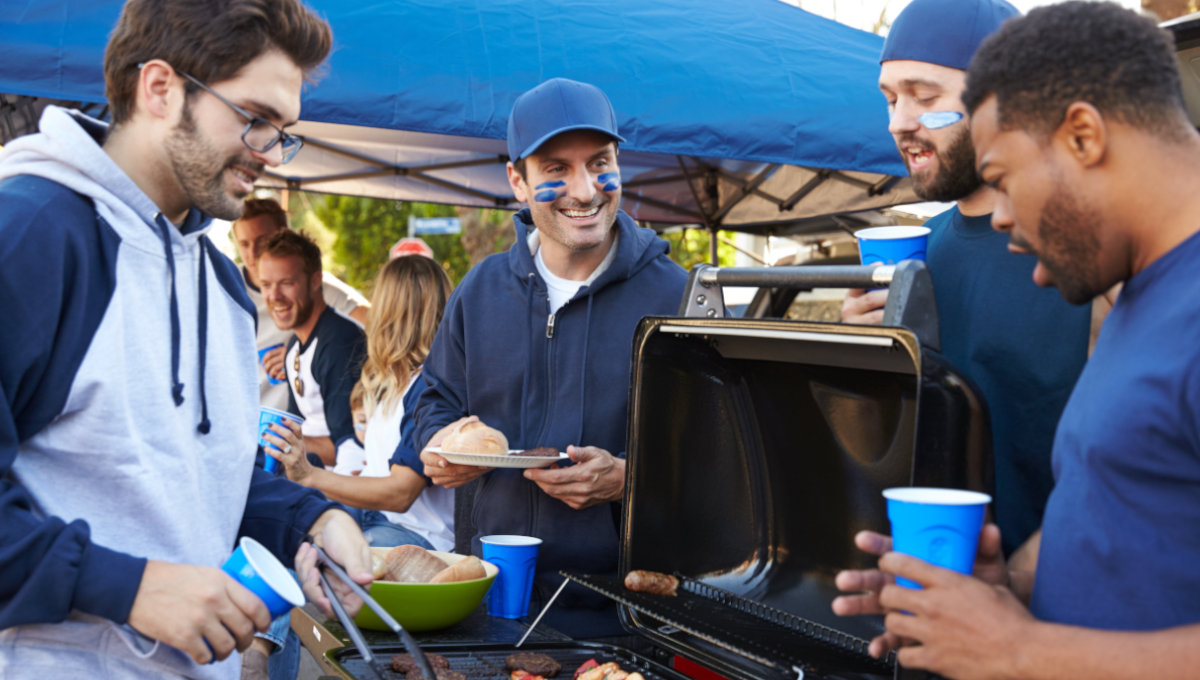Whether you’re a Nittany Lion, Pittsburgh Panther, Buckeye or Spartan fan, you’ll want to pay attention to these tips to prevent foodborne illness from ruining your fun.
Penn State Extension food safety experts have compiled pointers for those planning to tailgate this season and are offing tailgaters a free brochure of food safety tailgating tips that can be downloaded here.
The tips are written by Catherine Cutter, professor of food science in the College of Agricultural Sciences and Penn State Extension assistant director for food safety and quality programs.
Tips to avoid foodborne illness:
Preparing for a tailgate
- Properly defrost meat. Safe thawing of frozen meat items will keep them out of the temperature danger zone and below 40 degrees Fahrenheit or 4 degrees Celsius. When defrosting meat or other food items, allow enough time to thaw under refrigeration. Do not thaw frozen food items at outdoor temperatures.
- Use colored cutting boards and separate knives when prepping raw food such as meat and ready-to-eat food such as fresh vegetables to help prevent cross-contamination.
- Prepare a handwashing station. Prioritizing handwashing is key to preventing cross-contamination. Create a handwashing station by setting up a five-gallon water container with a spigot, paper towels, liquid soap, a trash bag and a bucket to catch wash water.
- Pack food-grade sanitizers such as disinfecting wipes or sprays for sanitizing food-contact surfaces.
- Pack separate drink, food and meat coolers to protect against temperature abuse from too much opening and closing of the coolers. Take enough ice to keep coolers below 40 degrees F/4 degrees C until the food is eaten or returned to the refrigerator.
- When ready for the tailgate, pack coolers last to help keep food items at their coldest.
Grilling at a tailgate
- Wash hands before handling food or eating and after touching raw meat, sneezing or coughing, handling garbage, setting up a canopy, petting the dog, or tossing around a football. In a pinch, tailgaters can use disposable antiseptic wet wipes for handwashing. Wipe hands thoroughly for 20 seconds. Hand sanitizers should not be used in place of proper handwashing unless handwashing facilities are impossible to set up (see time above).
- Keep raw meat cold and cooked meat hot. Remove meat from the cooler immediately before placing it on the grill. Cook only a portion of meat that will be consumed in two hours or less.
- Cook meat thoroughly. Make sure meat has reached the recommended internal temperature before consuming. Use a clean, properly calibrated thermometer to check the final internal cooking temperature of foods. Insert the food thermometer into the thickest portion of the meat.
- Do not use the color of the meat to determine proper cooking. Meat that has changed to a “cooked” color may not have reached the proper internal temperature to kill harmful bacteria.
| 140°F (60°C) | Grilled fruits, vegetables, baked beans Ready-to-eat foods (hot dogs, precooked sausages and wings) |
|---|---|
| 145°F (63°C) | Shrimp, Fish Beef, pork steaks and chops Brisket (185°F [85°C] for tenderness and slice ability) |
| 160°F (71°C) | Ground beef burgers, ribs, fresh sausage (bratwurst, breakfast links, sausage patties) Egg dishes |
| 165°F (74°C) | Turkey and vegan burgers, chicken wings, chicken, BBQ (beef, pulled pork, chicken) Chili, soups, stews, casseroles |
Serving at a tailgate
- Prevent cross-contamination by using clean utensils and plates for cooked meat. If possible, keep raw meat in a separate cooler, away from ready-to-eat foods. Otherwise, store raw meat in leakproof containers and under the ready-to-eat foods in the cooler. Juices from raw meat can contain bacteria that can contaminate cooked or ready-to-eat products.
- Make a note of the time the food should be thrown out. If food is left out for more than two hours, it must be discarded. In hot weather, above 90 degrees F/32 degrees C, food should sit out for no longer than one hour.
- Put food away once everyone has finished eating. Wrap everything that can be salvaged and discard everything else. All saved food should be placed in coolers for later use.
- Understand the temperature danger zone. Microorganisms, including those that cause foodborne illness, grow rapidly between 40 degrees F/4 C and 140 degrees F/60 C. Keep foods out of the temperature danger zone by storing, cooking, cooling and holding foods at the correct temperatures.
(To sign up for a free subscription to Food Safety News, click here)

